|
Puerto Rican Vireo Vireo latimeri Bien-te-veo,
|
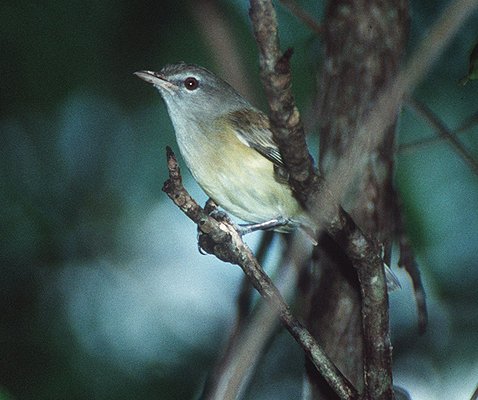 |
|
Photo: G. Beaton
|
|
Puerto Rican Vireo Vireo latimeri Bien-te-veo,
|
 |
|
Photo: G. Beaton
|
|
IDENTIFICATION: A small forest bird with a thick bill, gray head, white breast and light yellow belly. There are white crescents above and below the eye. Length: 12 cm.; weight: 11-12 g. VOICE: The loud song is reflected in its Spanish name: "bien-te-veo", with an accent on the first "e." Individuals sing several variants of this basic song throughout the day, but more frequently in the early morning. If one bird begins to sing, the vireos on neighboring territories will start to sing back, often with the same song variant. Audio 2 (M. Oberle). Like other vireos, it also has a scolding note when disturbed. HABITAT: Mountain forests, shade coffee plantations, coastal karst and thorn scrub forests with thick vine tangles. HABITS: The Puerto Rican Vireo moves slowly through the foliage, searching leaves for insect prey such as grasshoppers, cicadas, beetles, aphids and caterpillars. It also eats spiders, lizards and small berries. It prefers mid- to lower levels of trees, but because it forages slowly in thick vegetation and vine tangles, the bird may be difficult to locate despite its loud voice. Its nest is a cup on a tree limb and contains three pinkish eggs with brown spots. STATUS AND CONSERVATION: This bird is still locally common, especially in the thorn forests of the southwest and in the limestone hills. However, between 1973 and 1996, it steadily declined in Guánica State Forest and possibly elsewhere, most likely due to nest predation, as well as nest parasitism by the Shiny Cowbird (Molothrus bonariensis). RANGE: Endemic to Puerto Rico, where it occurs in the western two thirds of the island, less commonly in El Yunque. Regular locations to find this species are at the picnic area at Km 16.2 in Maricao State Forest, and in groves of taller trees in Guánica State Forest. TAXONOMY: PASSERIFORMES; VIREONIDAE |
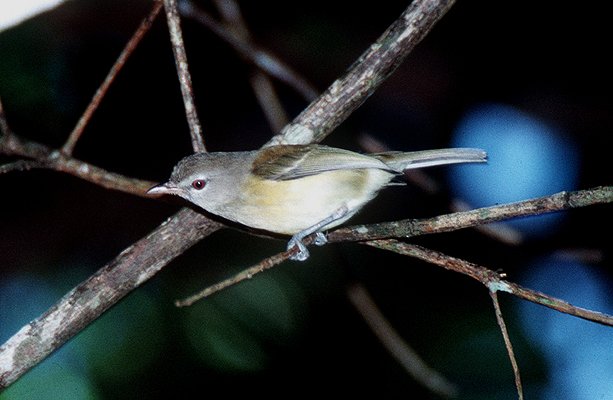 |
|
|
Photo: G. Beaton
|
 |
|
|
Photo: M. Oberle
|
 |
|
|
Photo: G. Beaton
|
 |
|
|
Photo: M. Oberle
|
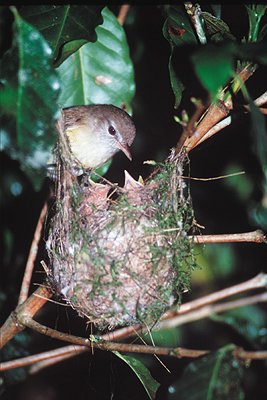 |
|
|
Photo: L. Miranda
|
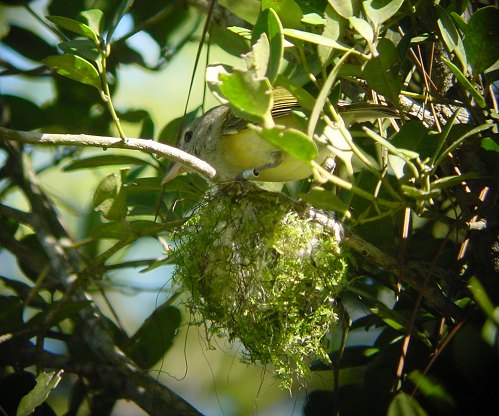 |
|
Photo: R. Rodríguez Mojica
|
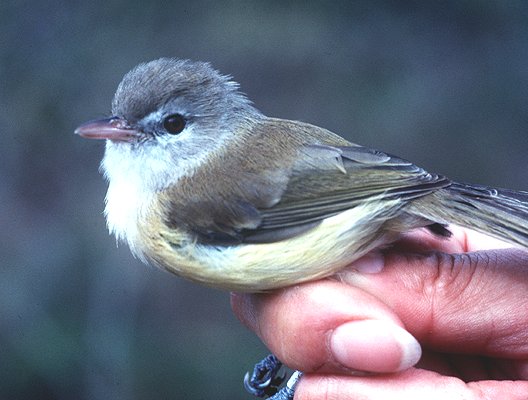 |
|
|
Photo: W. Arendt*
|
|
References Collazo, J.A. and Bonilla Martínez, G. I. 1988. Comparación de la riqueza de aves entre plantaciones de pino hondureño (Pinus caribaea) y áreas de bosque nativo en el Bosque Estatal de Carite, Cayey, Puerto Rico. Carib. J. Sci. 24:1-10. Cruz, A. 1980. Avian feeding assemblages in Puerto Rico. Carib. J. Sci. 15:21-27. Cruz, A. and C. A. Delannoy. 1984. Ecology of the Elfin Woods Warbler (Dendroica angelae) I. Distribution, habitat usage, and population densities. Carib. J. Sci. 20:89-96. Cruz, A. and C. A. Delannoy. 1984. Ecology of the Elfin Woods Warbler (Dendroica angelae) II. Feeding ecology of the Elfin Woods Warbler and associated insectivorous birds in Puerto Rico. Carib. J. Sci. 20:153-162. Faaborg, J., K.M. Dugger, W.J. Arendt, and M. Balty. 1997. Population declines of the Puerto Rican Vireo in Guánica forest. Wilson Bull. 109:195-202. Raffaele, H.A. 1989. A guide to the birds of Puerto Rico and the Virgin Islands. Princeton. Raffaele, H.A. 1989 Una guía a las aves de Puerto Rico y las Islas Vírgenes. Publishing Resources, Inc., Santurce, PR. Raffaele, H.A., J.W. Wiley, O.H. Garrido, A.R. Keith, and J.I. Raffaele. 1998. Guide to the birds of the West Indies. Princeton. Tossas, A. G. 1999. Exito reproductivo del Bienteveo de Puerto Rico. El Bien-te-veo 2(5):1-2. Woodworth, B.L. 1991. Impact of Shiny Cowbird parasitism on the reproductive success of the Puerto Rican Vireo in Guánica forest, Puerto Rico. El Pitirre. 4(3):9. Woodworth, B.L. 1997. Implications of introduced predators and parasites for the Puerto Rican Vireo in Guánica forest, Puerto Rico. El Pitirre 10(3):112-113. Woodworth, B. L. 1997. Brood parasitism, nest predation, and season-long reproductive success of a tropical island endemic. Condor 99:605-621. Woodworth, B. L., J. Faaborg, and W. J. Arendt. 1998. Breeding and natal dispersal in the Puerto Rican Vireo. J. Field Ornithol. 69:1-7. Woodworth, B. L. 1999. Modeling population dynamics of a songbird exposed to parasitism and predation and evaluating management options. Conservation Biology 13:67-76.
Woodworth, B. L., J. Faaborg, and W. J. Arendt. In press. Survival and longevity of the Puerto Rican Vireo. Wilson Bull. Zwartjes, P. W. 1999. Genetic variability in the endemic vireos of Puerto Rico and Jamaica contrasted with the continental White-eyed Vireo. Auk 116(4):964-975. Puerto Rican Vireo, Spanish text Next endemic species in taxonomic order Previous endemic species in taxonomic order |